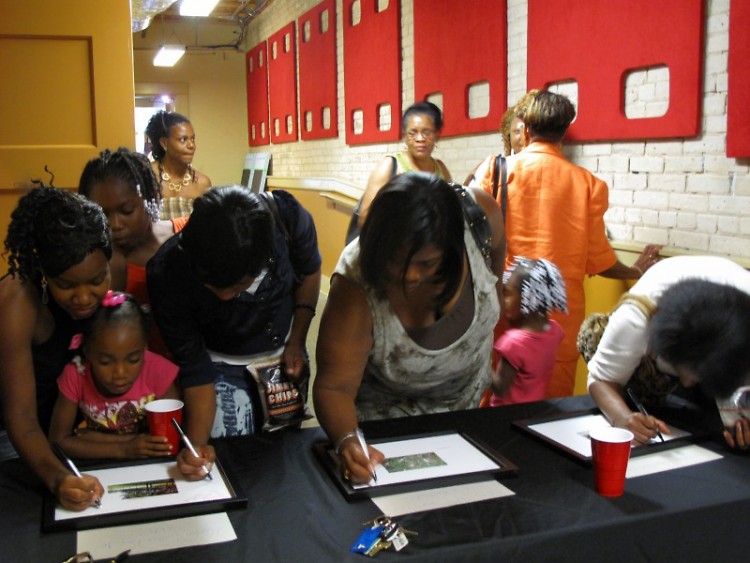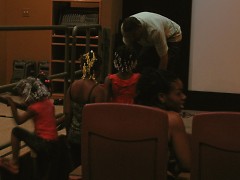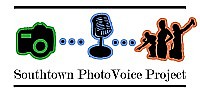Viewers were jumping out of their seats at Dirk Koning Microcinema last Friday evening as they debated the best way to improve Southtown neighborhoods.
Nearly 30 attendees gathered at Wealthy Theatre on July 30 to view Southtown PhotoVoice, a documentary and community assessment project faciliated by Lighthouse Communities. Southtown's boundaries are Wealthy to the north, Fuller to the east, Burton to the south and US-131 to the west and comprises Baxter, Madison Area Neighborhood Association, Oakdale Neighbors, South East Comunity Association and South East End Neighborhood Association.
Production began over a month ago and brought in 38 participants who were either dispatched with disposable cameras or interviewed for the documentary. Community photographers were assigned to take pictures that captured their perspectives of the neighborhood. Those photos were collaged into posters displays on Friday evening.
"The aim was to pair elders in the community with young'uns in the community to give two different perspectives," said Javonte Tubbs, a community liaison for Lighthouse. "When the little girl took the picture of Reardon's [party store] and Mr. El Amin seen it and said, 'you know, that used to be a funeral home,' that was the exact dynamic we were looking for."
Lighthouse's community liaisons recruited photography participants with the help of Seidman Boys and Girls Club. After Seidman identified willing youth, Lighthouse paired them with Southtown elders and leaders. The documentary was stitched together from sit-down and man-on-the-street interviews with community leaders and youth.
Youth noted problems such as gang violence and a need for leadership. One group of girls sounded off on where they wanted to live—New York City, Chicago, Atlanta, Florida—none answered Grand Rapids.
"Don't think we're all bad," said Bryan Anderson, a youth who echoed the same sentiment as other youth when recognizing gang violence.
Elders observed a lack of businesses owned by African Americans, a need for leadership for youth and neighborhood transience due to the low number of house owners.
"We don't need a ton of social workers, we don't need a ton of criminal justice people. We need people that can rebuild lives, physically build communities, be examples, become entrepreneurs." Taalib El Amin's words resonated with viewers, who cheered. "All the businesses in our neighborhood, we should own ... just like every other neighborhood."
Topics that came up during the post-screening discussion included youth engagement, entrepreneurship, politics, spreading news through the grapevine, the responsibility of older men to interact with young men, construction and churches' roles in the community.
"You can't do everything in a pulpit. Jesus didn't just stay in one particular block to do his work; he traveled from A to Z," said Dee Mayhue in encouraging Lighthouse to involve church leaders and their congregations.
Attendees expressed that they wanted the film screened at various community-based organizations. They also hoped Lighthouse would continue to engage residents in more photo community assessments at a minimum of once a year. There was talk of creating more documentaries based on issues teased out by the community assessment.
"It helped to make us a little bit more conscious and aware of what's acceptable and what's unacceptable in our community. We've gotten to the point where a lot of things have become acceptable and maybe 15 years ago, it wasn't acceptable," Javonte said. "We're kind of desensitized as far as our community being a reflection of the people who live in it. We want to get back to that ... this is just one step we took toward making it happen."
Boston Square resident Kimberly Williams and her family participated in the photography aspect of the project.
"It was a very unique experience for us because we do so much together, but to actually go out with that intent, it kind of put the whole project in another perspective for us. Like historians, almost. That was our mission: to see the city, to talk about the city," said Kimberly, who was excited to share her experience of the city with her kids. Kimberly's husband and son were later interviewed in the documentary.
"We need to clean up a lot more of our streets and stuff because all we do is pretty much throw all our trash on the ground, so we pretty much live in a trash can," said Victoria Williams, Kimberly's daughter.
Takara Taylor, also a community liaison for Lighthouse, felt the turnout was representative of Southtown.
"Our goal is to assess the needs in the community and address them," said Takara, whose next step is to create action plans. Citing litter in particular, she explained, "An action plan would be getting people to understand the importance of keeping your neighborhoods clean and how it can be perceived by people who don't live in the community that drive through it."
Lighthouse will be changing office locations from Madison SE within the year and plans on displaying project photos at the new facility. Lighthouse does not currently have plans to screen the documentary again but hopes this will be the first of an annual community assessment.
The Rapidian, a program of the 501(c)3 nonprofit Community Media Center, relies on the community’s support to help cover the cost of training reporters and publishing content.
We need your help.
If each of our readers and content creators who values this community platform help support its creation and maintenance, The Rapidian can continue to educate and facilitate a conversation around issues for years to come.
Please support The Rapidian and make a contribution today.




Comments
I would really love to see this documentary - will it be online?
Great story, Denise. The sources you quoted really make it some alive.
+ Tue 08/10/10 09:00 PM GRTV
+ Thu 08/12/10 09:30 AM GRTV
+ Fri 08/13/10 01:00 PM GRTV
+ Sat 08/14/10 10:30 AM GRTV
+ Sun 08/15/10 04:30 PM GRTV
We will eventually post it online after we make a few tweaks. I will make sure to notify the Rapidian when it will be available online. Thanks!
Takara Taylor, Community Liaison.
Denise,
This is a fantastic article. Good stuff and great topic.
i live just east of Boston Square, and i spend a lot of time in/around Southtown daily. It always makes me wonder what is really going on here and what is going on to make things better for everybody. Being in GR less than a year I still have much to learn, but I get the impression that it was once a really nice area that just needs some active participants to make it what it could/should be once again.